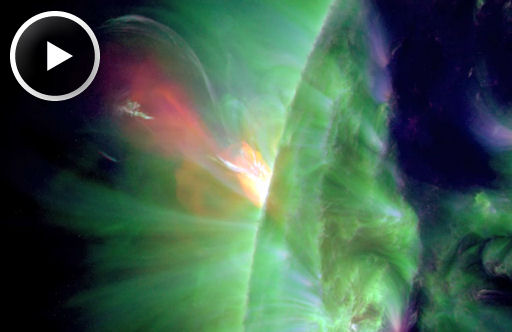ORIONID METEOR SHOWER: Next weekend, Earth will pass through a stream of debris from Halley's Comet, source of the annual Orionid meteor shower. Forecasters expect 25 meteors per hour when the shower peaks on Oct. 21st. [video] [full story]
LIGHTBULB ERUPTION: Sunspot AR1593, now emerging over the sun's northeastern limb, doesn't look very impressive. Yet two days ago it unleashed a very impressive eruption. NASA's Solar Dynamics Observatory recorded a glowing bulb of plasma more than 100,000 miles across on Oct. 14th:
The eruption occured while AR1593 was still on the farside of the sun, so Earth was not in the line of fire. Next time could be different. AR1593 will spend the next ~12 days facing our planet, setting the stage for geoeffective blasts if the sunspot erupts again. Stay tuned. Solar flare alerts: text, voice.

![]()
Solar wind
speed: 350.6 km/sec
density: 2.6 protons/cm3
explanation | more data
Updated: Today at 1537 UT
![]()
X-ray Solar Flares
6-hr max: B6 1011 UT Oct16
24-hr: C1 0653 UT Oct16
explanation | more data
Updated: Today at: 1459 UT
![]()
![]()
![]()
Daily Sun: 16 Oct 12
![]()
![]()
Sunspot 1589 poses a continued threat for Earth-directed M-class solar flares. Credit: SDO/HMI
![]()
![]()
![]()
Sunspot number: 119
What is the sunspot number?
Updated 16 Oct 2012
Spotless Days
Current Stretch: 0 days
2012 total: 0 days (0%)
2011 total: 2 days (<1%)
2010 total: 51 days (14%)
2009 total: 260 days (71%)
Since 2004: 821 days
Typical Solar Min: 486 days
Update 16 Oct 2012
The Radio Sun
10.7 cm flux: 137 sfu
explanation | more data
Updated 16 Oct 2012
![]()
![]()
![]()
Current Auroral Oval:
![]()
Switch to: Europe, USA, New Zealand, Antarctica
Credit: NOAA/POES
![]()
![]()
![]()
Planetary K-index
Now: Kp= 2 quiet
24-hr max: Kp= 2 quiet
explanation | more data
![]()
Interplanetary Mag. Field
Btotal: 3.5 nT
Bz: 1.6 nT north
explanation | more data
Updated: Today at 1537 UT
![]()
![]()
![]()
Coronal Holes: 16 Oct 12
![]()
![]()
There are no large coronal holes on the Earthside of the sun. Credit: SDO/AIA.





